Conflict Management Strategies and Organisational Performance Analysis
VerifiedAdded on 2022/11/25
|22
|4868
|231
Report
AI Summary
This report investigates the impact of conflict management on organisational performance within an Australian production and manufacturing firm. The study, based on a stratified random sample of 250 workers, utilized both inferential and descriptive statistics. A Spearman correlation analysis revealed a positive relationship between conflict management strategies and organisational performance, while non-integrative conflict management strategies had a negative effect. Regression analysis highlighted bargaining as the most positively correlated strategy. The report also discusses the emergence of conflicts due to goal and economic mismatches, with union-management conflicts being the most prevalent. The conclusion emphasizes that conflict is unavoidable but can either detract from or contribute to organisational performance depending on the conflict management methods employed.

RUUNING HEAD: CONFLICT MANAGEMENT
Conflict Management
Name of the student
Name of the University
Author Note
Conflict Management
Name of the student
Name of the University
Author Note
Paraphrase This Document
Need a fresh take? Get an instant paraphrase of this document with our AI Paraphraser
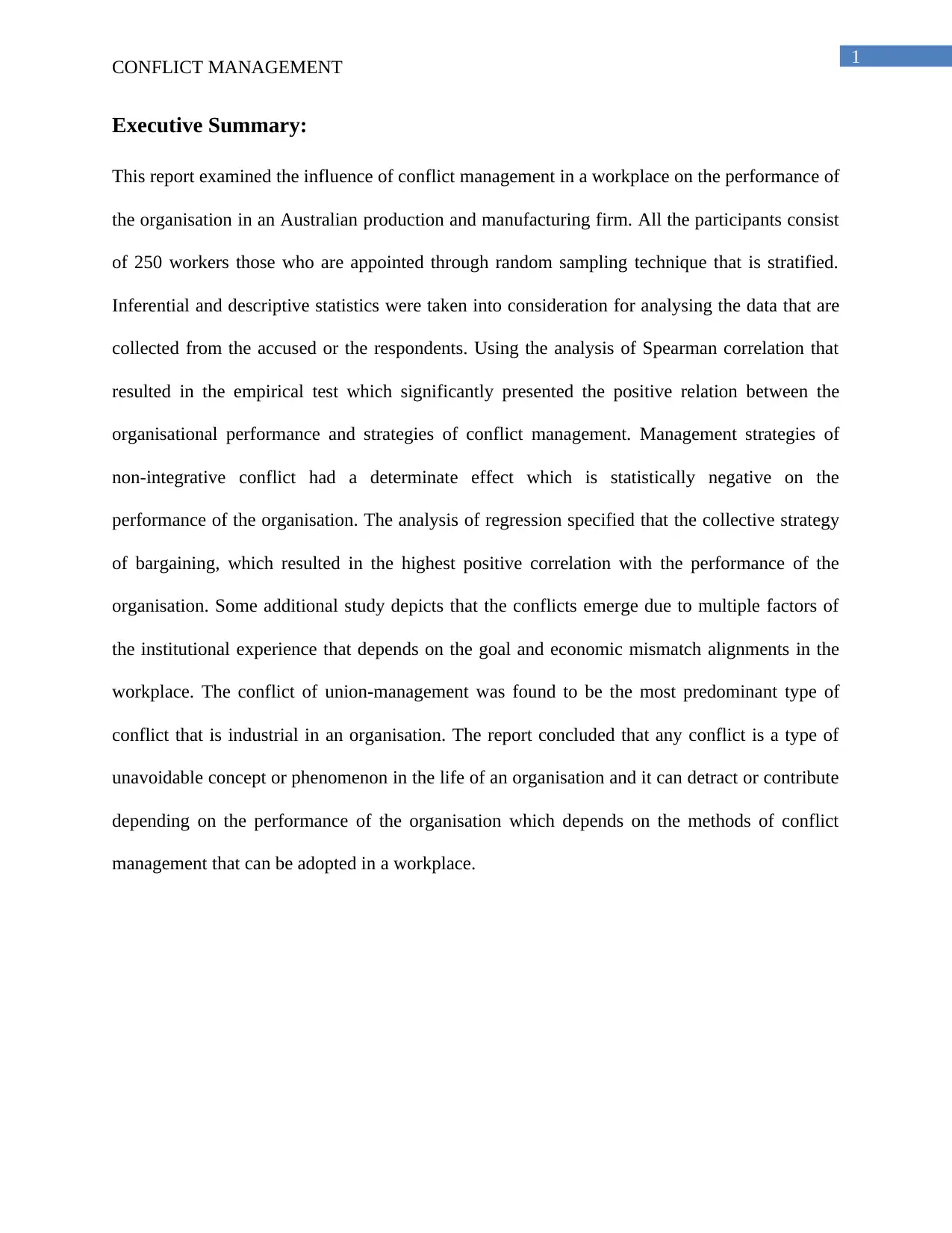
1
CONFLICT MANAGEMENT
Executive Summary:
This report examined the influence of conflict management in a workplace on the performance of
the organisation in an Australian production and manufacturing firm. All the participants consist
of 250 workers those who are appointed through random sampling technique that is stratified.
Inferential and descriptive statistics were taken into consideration for analysing the data that are
collected from the accused or the respondents. Using the analysis of Spearman correlation that
resulted in the empirical test which significantly presented the positive relation between the
organisational performance and strategies of conflict management. Management strategies of
non-integrative conflict had a determinate effect which is statistically negative on the
performance of the organisation. The analysis of regression specified that the collective strategy
of bargaining, which resulted in the highest positive correlation with the performance of the
organisation. Some additional study depicts that the conflicts emerge due to multiple factors of
the institutional experience that depends on the goal and economic mismatch alignments in the
workplace. The conflict of union-management was found to be the most predominant type of
conflict that is industrial in an organisation. The report concluded that any conflict is a type of
unavoidable concept or phenomenon in the life of an organisation and it can detract or contribute
depending on the performance of the organisation which depends on the methods of conflict
management that can be adopted in a workplace.
CONFLICT MANAGEMENT
Executive Summary:
This report examined the influence of conflict management in a workplace on the performance of
the organisation in an Australian production and manufacturing firm. All the participants consist
of 250 workers those who are appointed through random sampling technique that is stratified.
Inferential and descriptive statistics were taken into consideration for analysing the data that are
collected from the accused or the respondents. Using the analysis of Spearman correlation that
resulted in the empirical test which significantly presented the positive relation between the
organisational performance and strategies of conflict management. Management strategies of
non-integrative conflict had a determinate effect which is statistically negative on the
performance of the organisation. The analysis of regression specified that the collective strategy
of bargaining, which resulted in the highest positive correlation with the performance of the
organisation. Some additional study depicts that the conflicts emerge due to multiple factors of
the institutional experience that depends on the goal and economic mismatch alignments in the
workplace. The conflict of union-management was found to be the most predominant type of
conflict that is industrial in an organisation. The report concluded that any conflict is a type of
unavoidable concept or phenomenon in the life of an organisation and it can detract or contribute
depending on the performance of the organisation which depends on the methods of conflict
management that can be adopted in a workplace.

2
CONFLICT MANAGEMENT
Table of Contents
Introduction:....................................................................................................................................3
Discussion:.......................................................................................................................................4
Literature review:.........................................................................................................................4
Proposed Model for Resolution of Conflict:...................................................................................8
Methods for Resolution of Conflict:............................................................................................9
Best Suited Individual for Resolution of Conflict Model:...........................................................9
Context or Situation where the model should be used:...............................................................9
Signs or Cues that an Individual using a Model cam look for:.................................................10
Intrapersonal Signs or Cues while use of the Model:................................................................10
Interpersonal Signs or Cues while use of the Model:................................................................11
Essential Aspects of the Conflict Resolution Model:................................................................11
Conclusion:....................................................................................................................................13
Reference:......................................................................................................................................14
CONFLICT MANAGEMENT
Table of Contents
Introduction:....................................................................................................................................3
Discussion:.......................................................................................................................................4
Literature review:.........................................................................................................................4
Proposed Model for Resolution of Conflict:...................................................................................8
Methods for Resolution of Conflict:............................................................................................9
Best Suited Individual for Resolution of Conflict Model:...........................................................9
Context or Situation where the model should be used:...............................................................9
Signs or Cues that an Individual using a Model cam look for:.................................................10
Intrapersonal Signs or Cues while use of the Model:................................................................10
Interpersonal Signs or Cues while use of the Model:................................................................11
Essential Aspects of the Conflict Resolution Model:................................................................11
Conclusion:....................................................................................................................................13
Reference:......................................................................................................................................14
⊘ This is a preview!⊘
Do you want full access?
Subscribe today to unlock all pages.

Trusted by 1+ million students worldwide
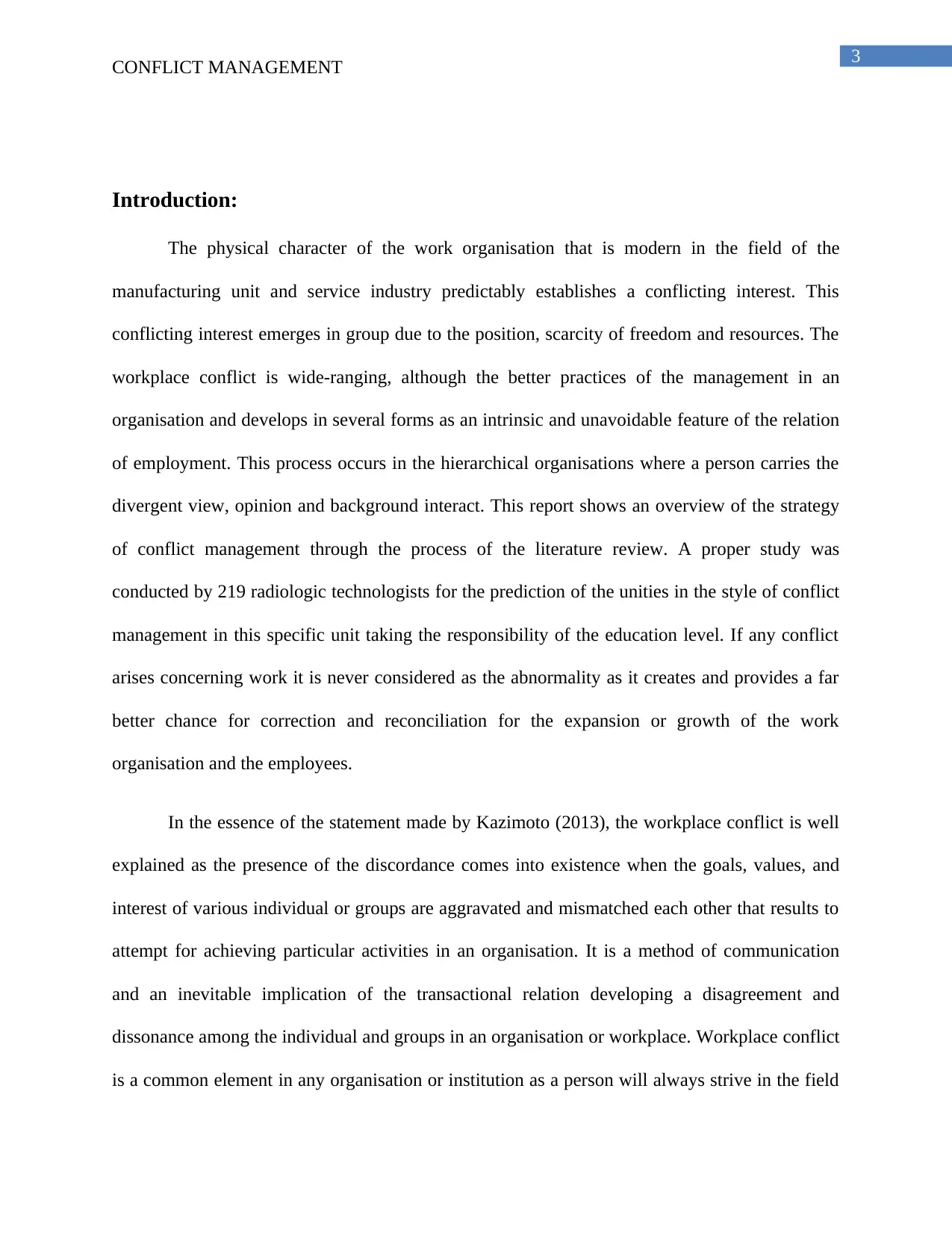
3
CONFLICT MANAGEMENT
Introduction:
The physical character of the work organisation that is modern in the field of the
manufacturing unit and service industry predictably establishes a conflicting interest. This
conflicting interest emerges in group due to the position, scarcity of freedom and resources. The
workplace conflict is wide-ranging, although the better practices of the management in an
organisation and develops in several forms as an intrinsic and unavoidable feature of the relation
of employment. This process occurs in the hierarchical organisations where a person carries the
divergent view, opinion and background interact. This report shows an overview of the strategy
of conflict management through the process of the literature review. A proper study was
conducted by 219 radiologic technologists for the prediction of the unities in the style of conflict
management in this specific unit taking the responsibility of the education level. If any conflict
arises concerning work it is never considered as the abnormality as it creates and provides a far
better chance for correction and reconciliation for the expansion or growth of the work
organisation and the employees.
In the essence of the statement made by Kazimoto (2013), the workplace conflict is well
explained as the presence of the discordance comes into existence when the goals, values, and
interest of various individual or groups are aggravated and mismatched each other that results to
attempt for achieving particular activities in an organisation. It is a method of communication
and an inevitable implication of the transactional relation developing a disagreement and
dissonance among the individual and groups in an organisation or workplace. Workplace conflict
is a common element in any organisation or institution as a person will always strive in the field
CONFLICT MANAGEMENT
Introduction:
The physical character of the work organisation that is modern in the field of the
manufacturing unit and service industry predictably establishes a conflicting interest. This
conflicting interest emerges in group due to the position, scarcity of freedom and resources. The
workplace conflict is wide-ranging, although the better practices of the management in an
organisation and develops in several forms as an intrinsic and unavoidable feature of the relation
of employment. This process occurs in the hierarchical organisations where a person carries the
divergent view, opinion and background interact. This report shows an overview of the strategy
of conflict management through the process of the literature review. A proper study was
conducted by 219 radiologic technologists for the prediction of the unities in the style of conflict
management in this specific unit taking the responsibility of the education level. If any conflict
arises concerning work it is never considered as the abnormality as it creates and provides a far
better chance for correction and reconciliation for the expansion or growth of the work
organisation and the employees.
In the essence of the statement made by Kazimoto (2013), the workplace conflict is well
explained as the presence of the discordance comes into existence when the goals, values, and
interest of various individual or groups are aggravated and mismatched each other that results to
attempt for achieving particular activities in an organisation. It is a method of communication
and an inevitable implication of the transactional relation developing a disagreement and
dissonance among the individual and groups in an organisation or workplace. Workplace conflict
is a common element in any organisation or institution as a person will always strive in the field
Paraphrase This Document
Need a fresh take? Get an instant paraphrase of this document with our AI Paraphraser
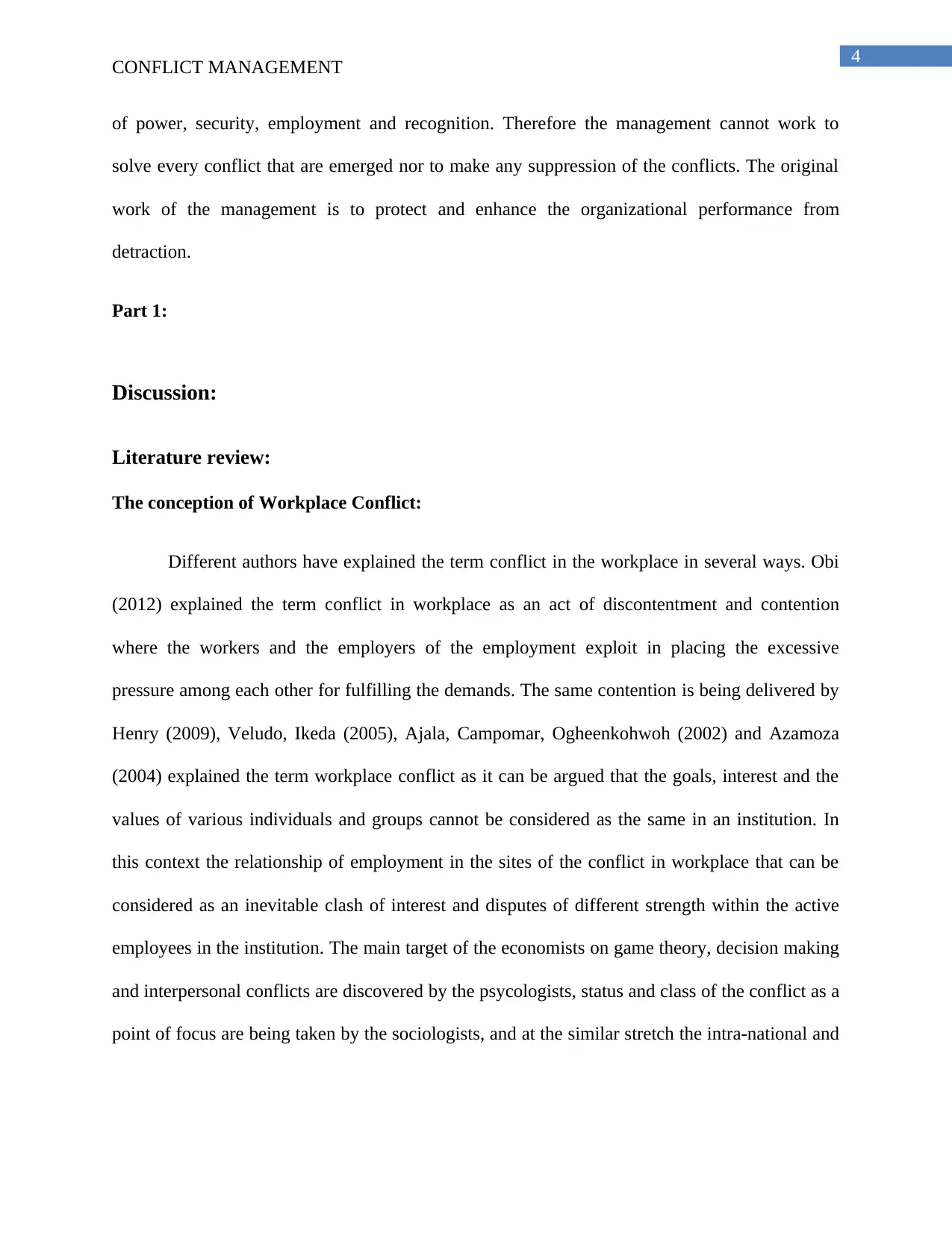
4
CONFLICT MANAGEMENT
of power, security, employment and recognition. Therefore the management cannot work to
solve every conflict that are emerged nor to make any suppression of the conflicts. The original
work of the management is to protect and enhance the organizational performance from
detraction.
Part 1:
Discussion:
Literature review:
The conception of Workplace Conflict:
Different authors have explained the term conflict in the workplace in several ways. Obi
(2012) explained the term conflict in workplace as an act of discontentment and contention
where the workers and the employers of the employment exploit in placing the excessive
pressure among each other for fulfilling the demands. The same contention is being delivered by
Henry (2009), Veludo, Ikeda (2005), Ajala, Campomar, Ogheenkohwoh (2002) and Azamoza
(2004) explained the term workplace conflict as it can be argued that the goals, interest and the
values of various individuals and groups cannot be considered as the same in an institution. In
this context the relationship of employment in the sites of the conflict in workplace that can be
considered as an inevitable clash of interest and disputes of different strength within the active
employees in the institution. The main target of the economists on game theory, decision making
and interpersonal conflicts are discovered by the psycologists, status and class of the conflict as a
point of focus are being taken by the sociologists, and at the similar stretch the intra-national and
CONFLICT MANAGEMENT
of power, security, employment and recognition. Therefore the management cannot work to
solve every conflict that are emerged nor to make any suppression of the conflicts. The original
work of the management is to protect and enhance the organizational performance from
detraction.
Part 1:
Discussion:
Literature review:
The conception of Workplace Conflict:
Different authors have explained the term conflict in the workplace in several ways. Obi
(2012) explained the term conflict in workplace as an act of discontentment and contention
where the workers and the employers of the employment exploit in placing the excessive
pressure among each other for fulfilling the demands. The same contention is being delivered by
Henry (2009), Veludo, Ikeda (2005), Ajala, Campomar, Ogheenkohwoh (2002) and Azamoza
(2004) explained the term workplace conflict as it can be argued that the goals, interest and the
values of various individuals and groups cannot be considered as the same in an institution. In
this context the relationship of employment in the sites of the conflict in workplace that can be
considered as an inevitable clash of interest and disputes of different strength within the active
employees in the institution. The main target of the economists on game theory, decision making
and interpersonal conflicts are discovered by the psycologists, status and class of the conflict as a
point of focus are being taken by the sociologists, and at the similar stretch the intra-national and
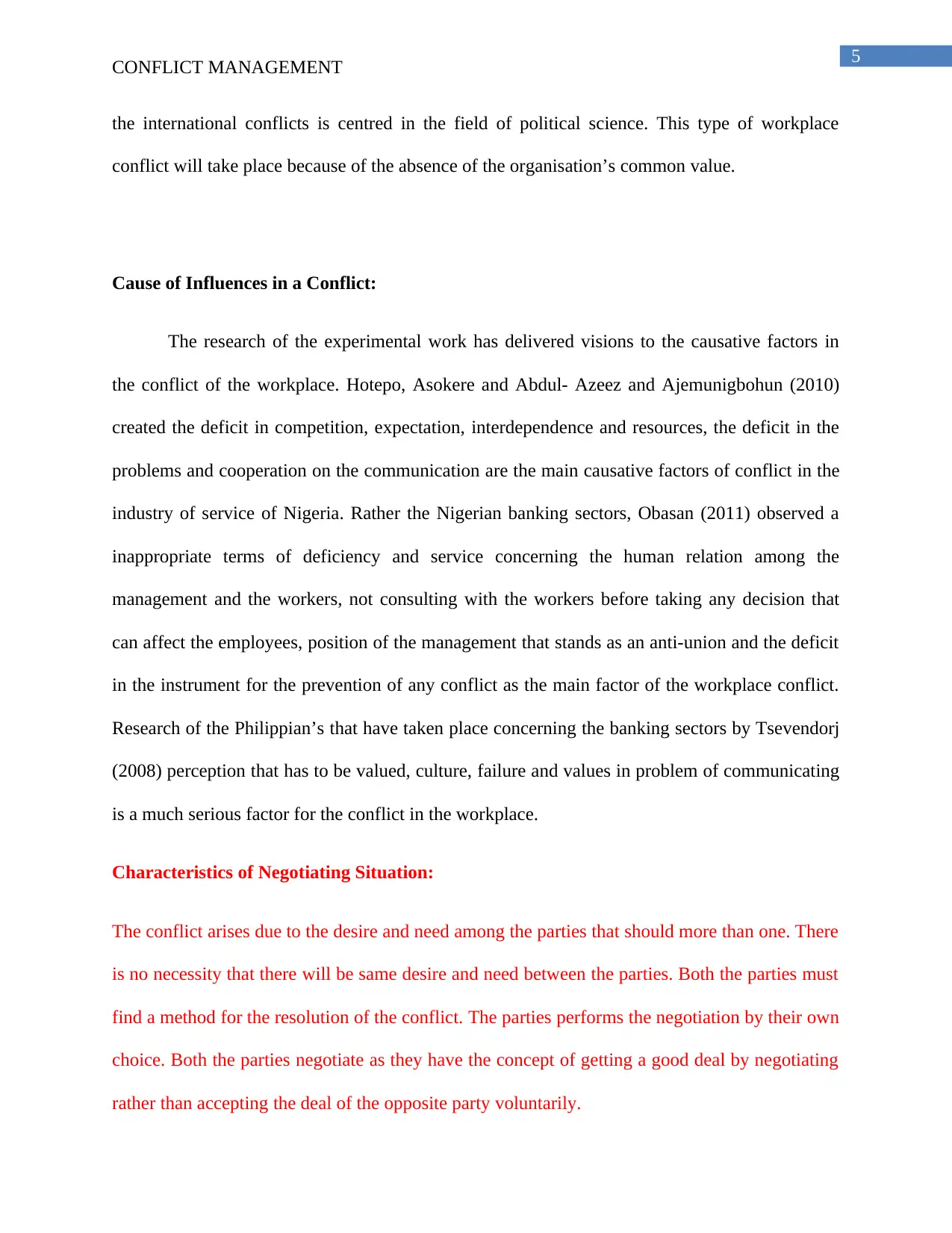
5
CONFLICT MANAGEMENT
the international conflicts is centred in the field of political science. This type of workplace
conflict will take place because of the absence of the organisation’s common value.
Cause of Influences in a Conflict:
The research of the experimental work has delivered visions to the causative factors in
the conflict of the workplace. Hotepo, Asokere and Abdul- Azeez and Ajemunigbohun (2010)
created the deficit in competition, expectation, interdependence and resources, the deficit in the
problems and cooperation on the communication are the main causative factors of conflict in the
industry of service of Nigeria. Rather the Nigerian banking sectors, Obasan (2011) observed a
inappropriate terms of deficiency and service concerning the human relation among the
management and the workers, not consulting with the workers before taking any decision that
can affect the employees, position of the management that stands as an anti-union and the deficit
in the instrument for the prevention of any conflict as the main factor of the workplace conflict.
Research of the Philippian’s that have taken place concerning the banking sectors by Tsevendorj
(2008) perception that has to be valued, culture, failure and values in problem of communicating
is a much serious factor for the conflict in the workplace.
Characteristics of Negotiating Situation:
The conflict arises due to the desire and need among the parties that should more than one. There
is no necessity that there will be same desire and need between the parties. Both the parties must
find a method for the resolution of the conflict. The parties performs the negotiation by their own
choice. Both the parties negotiate as they have the concept of getting a good deal by negotiating
rather than accepting the deal of the opposite party voluntarily.
CONFLICT MANAGEMENT
the international conflicts is centred in the field of political science. This type of workplace
conflict will take place because of the absence of the organisation’s common value.
Cause of Influences in a Conflict:
The research of the experimental work has delivered visions to the causative factors in
the conflict of the workplace. Hotepo, Asokere and Abdul- Azeez and Ajemunigbohun (2010)
created the deficit in competition, expectation, interdependence and resources, the deficit in the
problems and cooperation on the communication are the main causative factors of conflict in the
industry of service of Nigeria. Rather the Nigerian banking sectors, Obasan (2011) observed a
inappropriate terms of deficiency and service concerning the human relation among the
management and the workers, not consulting with the workers before taking any decision that
can affect the employees, position of the management that stands as an anti-union and the deficit
in the instrument for the prevention of any conflict as the main factor of the workplace conflict.
Research of the Philippian’s that have taken place concerning the banking sectors by Tsevendorj
(2008) perception that has to be valued, culture, failure and values in problem of communicating
is a much serious factor for the conflict in the workplace.
Characteristics of Negotiating Situation:
The conflict arises due to the desire and need among the parties that should more than one. There
is no necessity that there will be same desire and need between the parties. Both the parties must
find a method for the resolution of the conflict. The parties performs the negotiation by their own
choice. Both the parties negotiate as they have the concept of getting a good deal by negotiating
rather than accepting the deal of the opposite party voluntarily.
⊘ This is a preview!⊘
Do you want full access?
Subscribe today to unlock all pages.

Trusted by 1+ million students worldwide
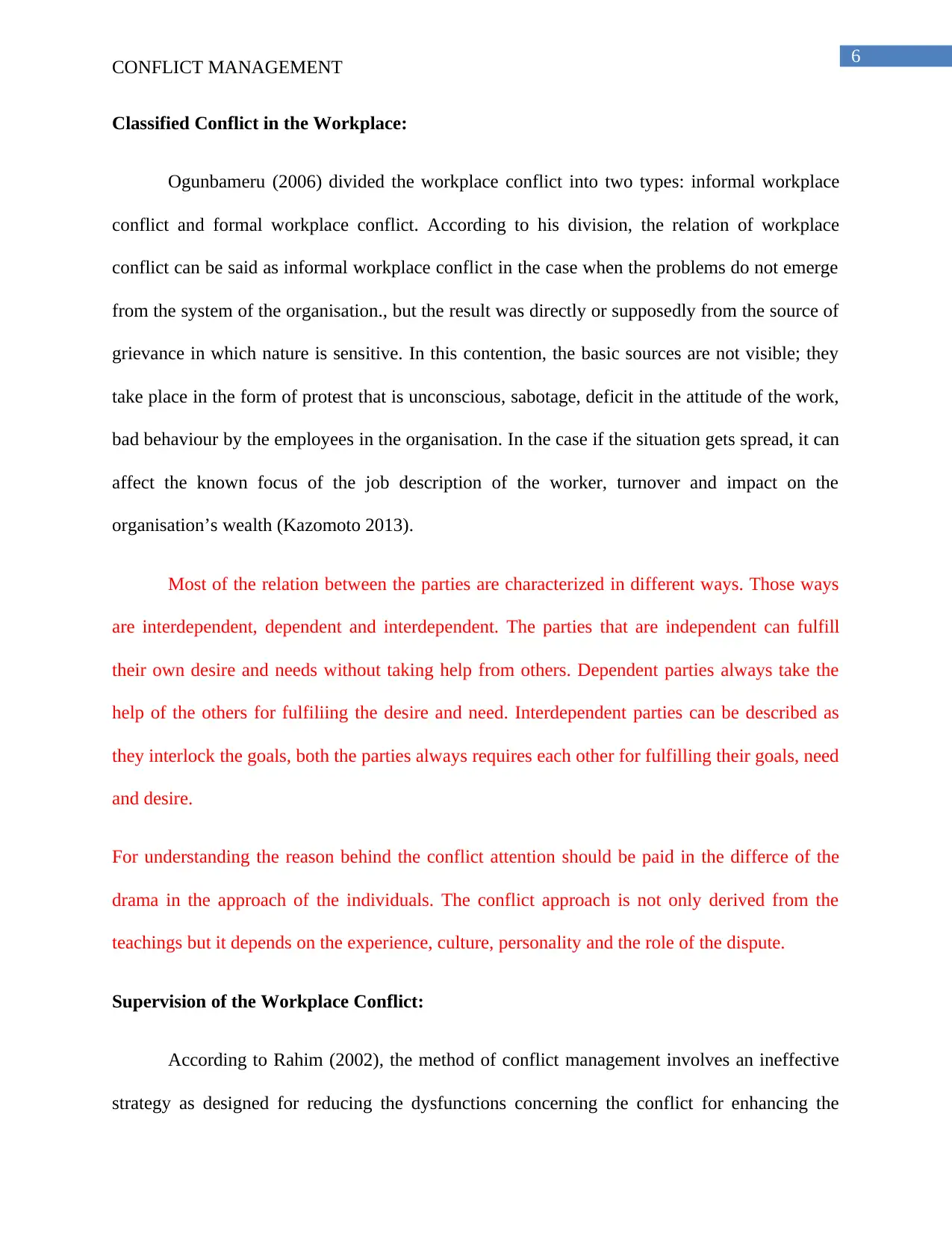
6
CONFLICT MANAGEMENT
Classified Conflict in the Workplace:
Ogunbameru (2006) divided the workplace conflict into two types: informal workplace
conflict and formal workplace conflict. According to his division, the relation of workplace
conflict can be said as informal workplace conflict in the case when the problems do not emerge
from the system of the organisation., but the result was directly or supposedly from the source of
grievance in which nature is sensitive. In this contention, the basic sources are not visible; they
take place in the form of protest that is unconscious, sabotage, deficit in the attitude of the work,
bad behaviour by the employees in the organisation. In the case if the situation gets spread, it can
affect the known focus of the job description of the worker, turnover and impact on the
organisation’s wealth (Kazomoto 2013).
Most of the relation between the parties are characterized in different ways. Those ways
are interdependent, dependent and interdependent. The parties that are independent can fulfill
their own desire and needs without taking help from others. Dependent parties always take the
help of the others for fulfiliing the desire and need. Interdependent parties can be described as
they interlock the goals, both the parties always requires each other for fulfilling their goals, need
and desire.
For understanding the reason behind the conflict attention should be paid in the differce of the
drama in the approach of the individuals. The conflict approach is not only derived from the
teachings but it depends on the experience, culture, personality and the role of the dispute.
Supervision of the Workplace Conflict:
According to Rahim (2002), the method of conflict management involves an ineffective
strategy as designed for reducing the dysfunctions concerning the conflict for enhancing the
CONFLICT MANAGEMENT
Classified Conflict in the Workplace:
Ogunbameru (2006) divided the workplace conflict into two types: informal workplace
conflict and formal workplace conflict. According to his division, the relation of workplace
conflict can be said as informal workplace conflict in the case when the problems do not emerge
from the system of the organisation., but the result was directly or supposedly from the source of
grievance in which nature is sensitive. In this contention, the basic sources are not visible; they
take place in the form of protest that is unconscious, sabotage, deficit in the attitude of the work,
bad behaviour by the employees in the organisation. In the case if the situation gets spread, it can
affect the known focus of the job description of the worker, turnover and impact on the
organisation’s wealth (Kazomoto 2013).
Most of the relation between the parties are characterized in different ways. Those ways
are interdependent, dependent and interdependent. The parties that are independent can fulfill
their own desire and needs without taking help from others. Dependent parties always take the
help of the others for fulfiliing the desire and need. Interdependent parties can be described as
they interlock the goals, both the parties always requires each other for fulfilling their goals, need
and desire.
For understanding the reason behind the conflict attention should be paid in the differce of the
drama in the approach of the individuals. The conflict approach is not only derived from the
teachings but it depends on the experience, culture, personality and the role of the dispute.
Supervision of the Workplace Conflict:
According to Rahim (2002), the method of conflict management involves an ineffective
strategy as designed for reducing the dysfunctions concerning the conflict for enhancing the
Paraphrase This Document
Need a fresh take? Get an instant paraphrase of this document with our AI Paraphraser

7
CONFLICT MANAGEMENT
purpose of constructing the optimisation of the learning and effectiveness of an organisation.
Managing a compromised conflict includes a strategy or a method for getting a “mutual ground”
which will be satisfying the alternative party partly. Taking this type of strategy in action makes
an individual realise all the individuals cannot be fully satisfied when a conflict emerges. This
concludes the management of conflict that is not possible to be avoided and terminated, but it
reduces the escalation chance that is of no use or unproductive. Management of conflict is a
technique that accelerates in handling of the grievance of an organisation or an individual for
getting an alternate way for increment of the resolving effort heading towards the purpose and
agreement of a decision making that is genuine. As it is invented by Odigwe (2013) and
Uchendu, Anijaobi as it is not possible to avoid a conflict in an organisation, in the particular
case the administration of the company will make the decision about the positive and negative
effect of the organisational performance. This timely recognition and immediate implication of
the basic tension before the conflict issue goes out of the reach and are relevant in the
management of conflict in the workplace.
Conflict can be avoided in the following ways:
It can be avoided through the premature way of problem solving
It can be avoided through denial
It can be avoided through surrogates
It can be avoided by the way folding
CONFLICT MANAGEMENT
purpose of constructing the optimisation of the learning and effectiveness of an organisation.
Managing a compromised conflict includes a strategy or a method for getting a “mutual ground”
which will be satisfying the alternative party partly. Taking this type of strategy in action makes
an individual realise all the individuals cannot be fully satisfied when a conflict emerges. This
concludes the management of conflict that is not possible to be avoided and terminated, but it
reduces the escalation chance that is of no use or unproductive. Management of conflict is a
technique that accelerates in handling of the grievance of an organisation or an individual for
getting an alternate way for increment of the resolving effort heading towards the purpose and
agreement of a decision making that is genuine. As it is invented by Odigwe (2013) and
Uchendu, Anijaobi as it is not possible to avoid a conflict in an organisation, in the particular
case the administration of the company will make the decision about the positive and negative
effect of the organisational performance. This timely recognition and immediate implication of
the basic tension before the conflict issue goes out of the reach and are relevant in the
management of conflict in the workplace.
Conflict can be avoided in the following ways:
It can be avoided through the premature way of problem solving
It can be avoided through denial
It can be avoided through surrogates
It can be avoided by the way folding
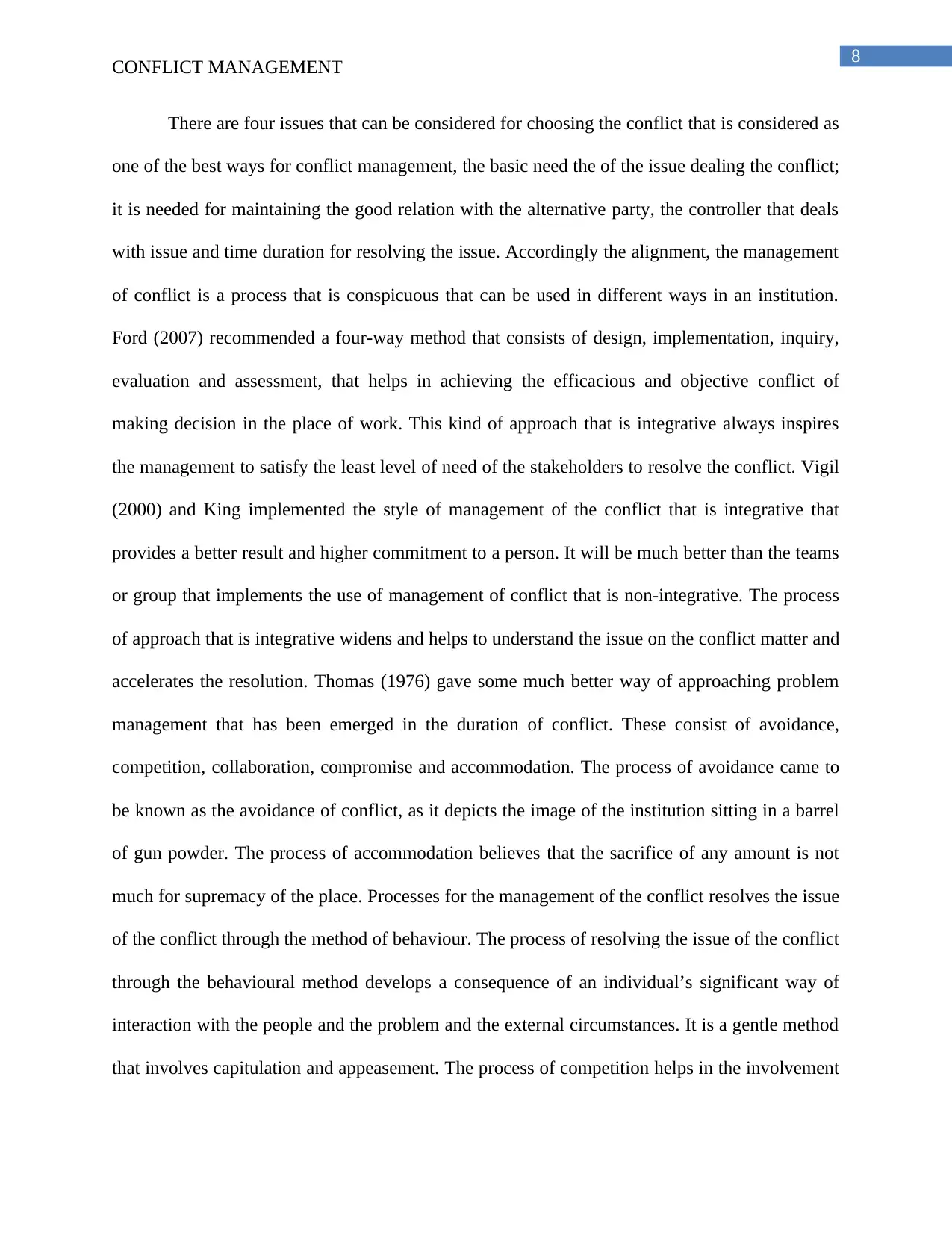
8
CONFLICT MANAGEMENT
There are four issues that can be considered for choosing the conflict that is considered as
one of the best ways for conflict management, the basic need the of the issue dealing the conflict;
it is needed for maintaining the good relation with the alternative party, the controller that deals
with issue and time duration for resolving the issue. Accordingly the alignment, the management
of conflict is a process that is conspicuous that can be used in different ways in an institution.
Ford (2007) recommended a four-way method that consists of design, implementation, inquiry,
evaluation and assessment, that helps in achieving the efficacious and objective conflict of
making decision in the place of work. This kind of approach that is integrative always inspires
the management to satisfy the least level of need of the stakeholders to resolve the conflict. Vigil
(2000) and King implemented the style of management of the conflict that is integrative that
provides a better result and higher commitment to a person. It will be much better than the teams
or group that implements the use of management of conflict that is non-integrative. The process
of approach that is integrative widens and helps to understand the issue on the conflict matter and
accelerates the resolution. Thomas (1976) gave some much better way of approaching problem
management that has been emerged in the duration of conflict. These consist of avoidance,
competition, collaboration, compromise and accommodation. The process of avoidance came to
be known as the avoidance of conflict, as it depicts the image of the institution sitting in a barrel
of gun powder. The process of accommodation believes that the sacrifice of any amount is not
much for supremacy of the place. Processes for the management of the conflict resolves the issue
of the conflict through the method of behaviour. The process of resolving the issue of the conflict
through the behavioural method develops a consequence of an individual’s significant way of
interaction with the people and the problem and the external circumstances. It is a gentle method
that involves capitulation and appeasement. The process of competition helps in the involvement
CONFLICT MANAGEMENT
There are four issues that can be considered for choosing the conflict that is considered as
one of the best ways for conflict management, the basic need the of the issue dealing the conflict;
it is needed for maintaining the good relation with the alternative party, the controller that deals
with issue and time duration for resolving the issue. Accordingly the alignment, the management
of conflict is a process that is conspicuous that can be used in different ways in an institution.
Ford (2007) recommended a four-way method that consists of design, implementation, inquiry,
evaluation and assessment, that helps in achieving the efficacious and objective conflict of
making decision in the place of work. This kind of approach that is integrative always inspires
the management to satisfy the least level of need of the stakeholders to resolve the conflict. Vigil
(2000) and King implemented the style of management of the conflict that is integrative that
provides a better result and higher commitment to a person. It will be much better than the teams
or group that implements the use of management of conflict that is non-integrative. The process
of approach that is integrative widens and helps to understand the issue on the conflict matter and
accelerates the resolution. Thomas (1976) gave some much better way of approaching problem
management that has been emerged in the duration of conflict. These consist of avoidance,
competition, collaboration, compromise and accommodation. The process of avoidance came to
be known as the avoidance of conflict, as it depicts the image of the institution sitting in a barrel
of gun powder. The process of accommodation believes that the sacrifice of any amount is not
much for supremacy of the place. Processes for the management of the conflict resolves the issue
of the conflict through the method of behaviour. The process of resolving the issue of the conflict
through the behavioural method develops a consequence of an individual’s significant way of
interaction with the people and the problem and the external circumstances. It is a gentle method
that involves capitulation and appeasement. The process of competition helps in the involvement
⊘ This is a preview!⊘
Do you want full access?
Subscribe today to unlock all pages.

Trusted by 1+ million students worldwide

9
CONFLICT MANAGEMENT
of the fittest method and win-lose method without considering the grant of any other party. In the
process of compromise the parties that are conflicting always leaves some or the other thing for
the settlement of the issue or problem of the conflict. The final approach is the collaboration
strategy that clearly explains that it is a type of win-win approach where the parties in conflict
get prepared and ready willingly for the full satisfaction of the claim. In the collaboration
strategy the exception reflecting in the behaviour is cooperative and assertive, all other
approaches depend on the structure of the organisation as they provide a resolution in a very
short time for the conflicted situation.
Bernard Mayer (2000), has pointed to how there can be different ways by which conflict
is approached and managed. In the view of Mayer (2000), some of the ways by which conflict is
managed at the workplace depends not only on what people have been taught about conflict but
also about the ways and means by which they should approach the subject of conflict. It is also
something that in the view of Mayer (2000) is greatly dependent on the type of conflict that
people have experienced in their lives and the ways and means that they have adopted in order to
manage such conflict in the first place. According to Mayer (2000), there are four main factors
that appear to be significant when it comes to understanding and implementing conflict
management. These are the beliefs and the values that a person has about conflict, the various
approaches that can be taken for the avoidance of conflict and also for engaging in conflict, the
style of conflict that are seen to find manifestation in the workplace as also the roles that people
are seen to play in both initiating conflict as well as in the management of conflict. Over and
above pointing out the main factors that influence conflict management, the research also points
to some of the novel ways by which conflict can be managed at the workplace such as the
CONFLICT MANAGEMENT
of the fittest method and win-lose method without considering the grant of any other party. In the
process of compromise the parties that are conflicting always leaves some or the other thing for
the settlement of the issue or problem of the conflict. The final approach is the collaboration
strategy that clearly explains that it is a type of win-win approach where the parties in conflict
get prepared and ready willingly for the full satisfaction of the claim. In the collaboration
strategy the exception reflecting in the behaviour is cooperative and assertive, all other
approaches depend on the structure of the organisation as they provide a resolution in a very
short time for the conflicted situation.
Bernard Mayer (2000), has pointed to how there can be different ways by which conflict
is approached and managed. In the view of Mayer (2000), some of the ways by which conflict is
managed at the workplace depends not only on what people have been taught about conflict but
also about the ways and means by which they should approach the subject of conflict. It is also
something that in the view of Mayer (2000) is greatly dependent on the type of conflict that
people have experienced in their lives and the ways and means that they have adopted in order to
manage such conflict in the first place. According to Mayer (2000), there are four main factors
that appear to be significant when it comes to understanding and implementing conflict
management. These are the beliefs and the values that a person has about conflict, the various
approaches that can be taken for the avoidance of conflict and also for engaging in conflict, the
style of conflict that are seen to find manifestation in the workplace as also the roles that people
are seen to play in both initiating conflict as well as in the management of conflict. Over and
above pointing out the main factors that influence conflict management, the research also points
to some of the novel ways by which conflict can be managed at the workplace such as the
Paraphrase This Document
Need a fresh take? Get an instant paraphrase of this document with our AI Paraphraser
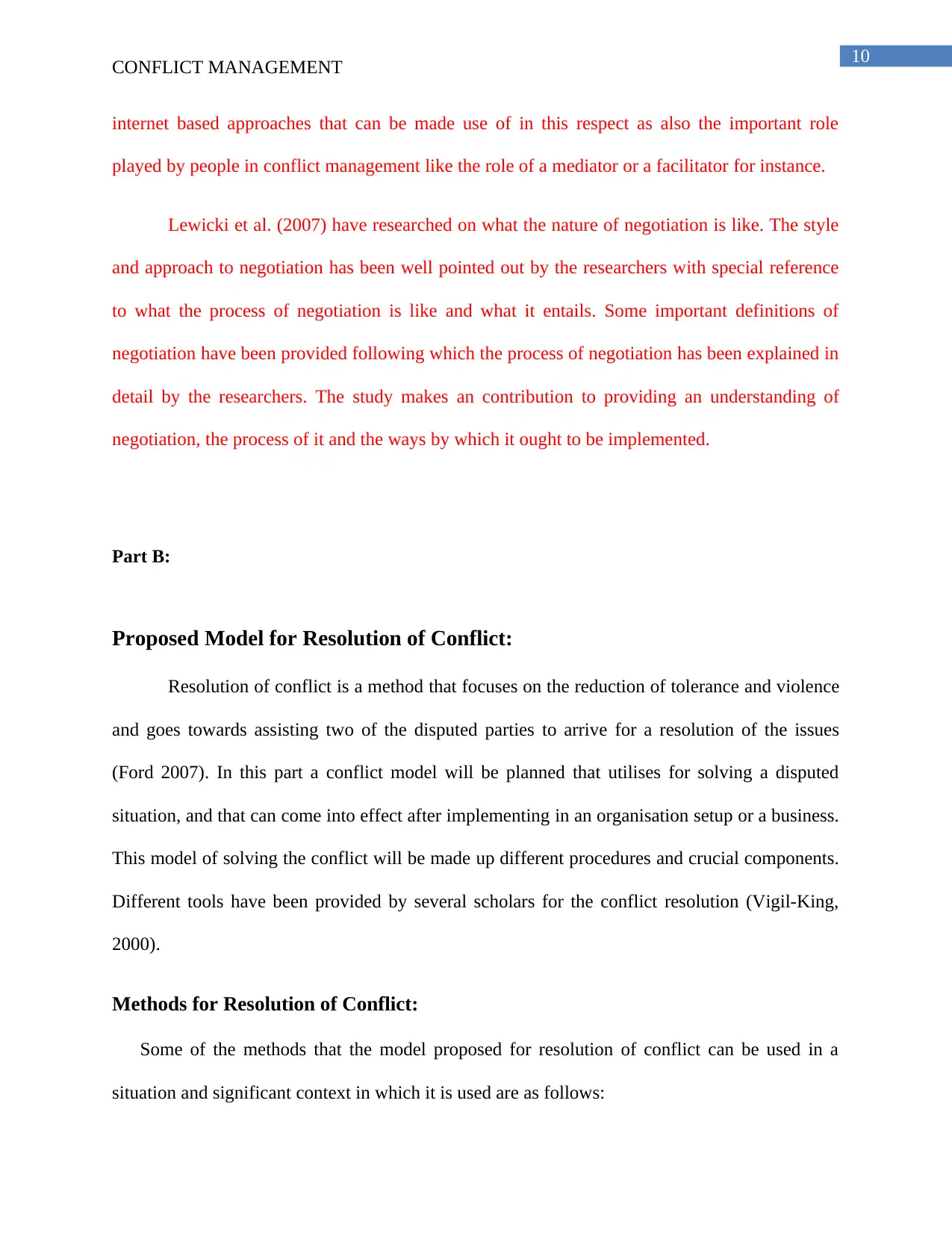
10
CONFLICT MANAGEMENT
internet based approaches that can be made use of in this respect as also the important role
played by people in conflict management like the role of a mediator or a facilitator for instance.
Lewicki et al. (2007) have researched on what the nature of negotiation is like. The style
and approach to negotiation has been well pointed out by the researchers with special reference
to what the process of negotiation is like and what it entails. Some important definitions of
negotiation have been provided following which the process of negotiation has been explained in
detail by the researchers. The study makes an contribution to providing an understanding of
negotiation, the process of it and the ways by which it ought to be implemented.
Part B:
Proposed Model for Resolution of Conflict:
Resolution of conflict is a method that focuses on the reduction of tolerance and violence
and goes towards assisting two of the disputed parties to arrive for a resolution of the issues
(Ford 2007). In this part a conflict model will be planned that utilises for solving a disputed
situation, and that can come into effect after implementing in an organisation setup or a business.
This model of solving the conflict will be made up different procedures and crucial components.
Different tools have been provided by several scholars for the conflict resolution (Vigil-King,
2000).
Methods for Resolution of Conflict:
Some of the methods that the model proposed for resolution of conflict can be used in a
situation and significant context in which it is used are as follows:
CONFLICT MANAGEMENT
internet based approaches that can be made use of in this respect as also the important role
played by people in conflict management like the role of a mediator or a facilitator for instance.
Lewicki et al. (2007) have researched on what the nature of negotiation is like. The style
and approach to negotiation has been well pointed out by the researchers with special reference
to what the process of negotiation is like and what it entails. Some important definitions of
negotiation have been provided following which the process of negotiation has been explained in
detail by the researchers. The study makes an contribution to providing an understanding of
negotiation, the process of it and the ways by which it ought to be implemented.
Part B:
Proposed Model for Resolution of Conflict:
Resolution of conflict is a method that focuses on the reduction of tolerance and violence
and goes towards assisting two of the disputed parties to arrive for a resolution of the issues
(Ford 2007). In this part a conflict model will be planned that utilises for solving a disputed
situation, and that can come into effect after implementing in an organisation setup or a business.
This model of solving the conflict will be made up different procedures and crucial components.
Different tools have been provided by several scholars for the conflict resolution (Vigil-King,
2000).
Methods for Resolution of Conflict:
Some of the methods that the model proposed for resolution of conflict can be used in a
situation and significant context in which it is used are as follows:

11
CONFLICT MANAGEMENT
Staying calmly is an essential need in the place of conflict
The matter should be heard carefully for understanding the reason behind the conflict
To emphasise about the positive side in the situation of conflict
The case of the resolution of conflict should be handled in the best possible tactful
manner.
The parties should be encouraged for attacking the situation due to which the conflict
arose rather than attacking each other.
There should be a surety the blame game should be avoided for the resolution of the
conflict(Rahim,2002).
Best Suited Individual for Resolution of Conflict Model:
The individual those are fitted best make the use of the resolution of conflict management
that is being recently proposed, are the individuals those can easily witness the conflict
management taking place and those who get the employment of the supervisory and managerial
capacity of the institution. In the case of a situation of a conflict in an institution, it is given to the
people in charge for resolving the matter as fast as possible for keeping such a situation effort
should be given form emerging it ever in the future. (Vigil-King, 2000).
Context or Situation where the model should be used:
This is resolution of the model of conflict that can be used in a organizational setting or a
business setup where the emerging conflicts comes up at any point of time over the distinction
between among supervisors and the employees, distinction between among the colleagues,
distinction among the workers over cultural ethnic and religious differences that includes the
working style, eating habit and the differences over the approach to a business situation or a
particular project (Ford 2007).
CONFLICT MANAGEMENT
Staying calmly is an essential need in the place of conflict
The matter should be heard carefully for understanding the reason behind the conflict
To emphasise about the positive side in the situation of conflict
The case of the resolution of conflict should be handled in the best possible tactful
manner.
The parties should be encouraged for attacking the situation due to which the conflict
arose rather than attacking each other.
There should be a surety the blame game should be avoided for the resolution of the
conflict(Rahim,2002).
Best Suited Individual for Resolution of Conflict Model:
The individual those are fitted best make the use of the resolution of conflict management
that is being recently proposed, are the individuals those can easily witness the conflict
management taking place and those who get the employment of the supervisory and managerial
capacity of the institution. In the case of a situation of a conflict in an institution, it is given to the
people in charge for resolving the matter as fast as possible for keeping such a situation effort
should be given form emerging it ever in the future. (Vigil-King, 2000).
Context or Situation where the model should be used:
This is resolution of the model of conflict that can be used in a organizational setting or a
business setup where the emerging conflicts comes up at any point of time over the distinction
between among supervisors and the employees, distinction between among the colleagues,
distinction among the workers over cultural ethnic and religious differences that includes the
working style, eating habit and the differences over the approach to a business situation or a
particular project (Ford 2007).
⊘ This is a preview!⊘
Do you want full access?
Subscribe today to unlock all pages.

Trusted by 1+ million students worldwide
1 out of 22
Related Documents
Your All-in-One AI-Powered Toolkit for Academic Success.
+13062052269
info@desklib.com
Available 24*7 on WhatsApp / Email
![[object Object]](/_next/static/media/star-bottom.7253800d.svg)
Unlock your academic potential
Copyright © 2020–2025 A2Z Services. All Rights Reserved. Developed and managed by ZUCOL.





